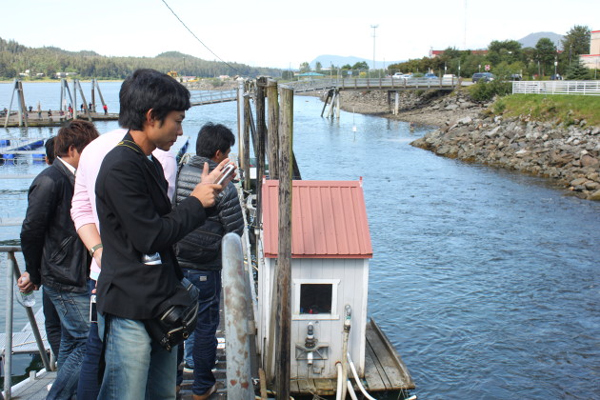
A group of Japanese fishermen is touring the Northwest United States to get an education in fisheries. The group’s first stop was Juneau where they toured the hatchery at DIPAC Monday morning.
37-year-old Fumihiro Sugawara is a chum salmon fisherman in Rausu, which is located in the northeast of Hokkaido Island in Japan. He’s been fishing for 16 years.
He and 12 other Japanese fishermen are visiting Alaska for the first time.
“In the last few years, amount of their salmon and trout is declining, so they want to learn some of the idea from Alaska salmon fish industry and to enhance their business in Japan,” says Yoshimi Sato interpreting for Sugawara.
Sugawara says he learned a lot after touring DIPAC’s Macaulay hatchery Monday morning.
“He was impressed by the way they catch directly from their ocean and then release directly into ocean,” Sato says.
In Japan, hatcheries release juvenile chum salmon in rivers. In Alaska, they’re released in the open ocean.
The group also heard presentations by the Alaska Department of Fish and Game. Sam Rabung is the state’s hatchery program coordinator.
“Alaska’s hatchery program is unique and Alaska’s salmon fisheries are unique. We manage differently than just about anywhere in the world,” Rabung says.
Alaska’s fisheries are managed to maintain the wild stock population.
“It’s a really strange concept to a lot of people from around the world who are more familiar with just harvesting quotas. We don’t want to forego harvest opportunity and conversely, if there are unanticipated weak runs, we can rein things in,” Rabung says.
The more people from around the world know about Alaska fisheries, the better, he says.
“We think it’s important that other countries realize that our fisheries are managed sustainably. They always have been. It’s not new to us. It’s in our constitution and it’s one of the reasons we’re a state, and we think it’s important to spread that message,” Rabung says.
Shunji Murakami is traveling with the fishermen as the group’s main interpreter. He’s based in Japan and is a consultant for the Wild Salmon Center, a Portland-based nonprofit that works to protect wild salmon and the ecosystems they depend on.
“Alaska is such a rich country in terms of environment for salmon, but in Japan, 98 percent of our rivers are dammed and we have scarcity of wild salmon population,” Murakami says.
He says the group of young fishermen came to Alaska to learn from the best. The hope is they will spread the message of sustainability to others back home.
“We cannot apply Alaskan way of resources management a hundred percent to Japan but, to some extent, we can kind of learn from the resource management that’s going on here and apply that in Japan, where environmentally [it’s] a little bit poor, to rehabilitate the wild populations,” Murakami says.
The Japanese fishermen want to expand their international market. One of the ways of doing that is getting their fish certified by the Marine Stewardship Council. Murakami says that’s another incentive to make their fisheries more sustainable.
“So then they can make money and, at the same time, do the right thing,” he says.
The group travels to Sitka next to meet with the Northern Southeast Regional Aquaculture Association. They’ll also go to Portland and visit the Bonneville Hatchery which is run by the Oregon Department of Fish and Wildlife.
Lisa Phu is a reporter at KTOO in Juneau.




